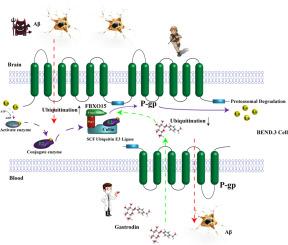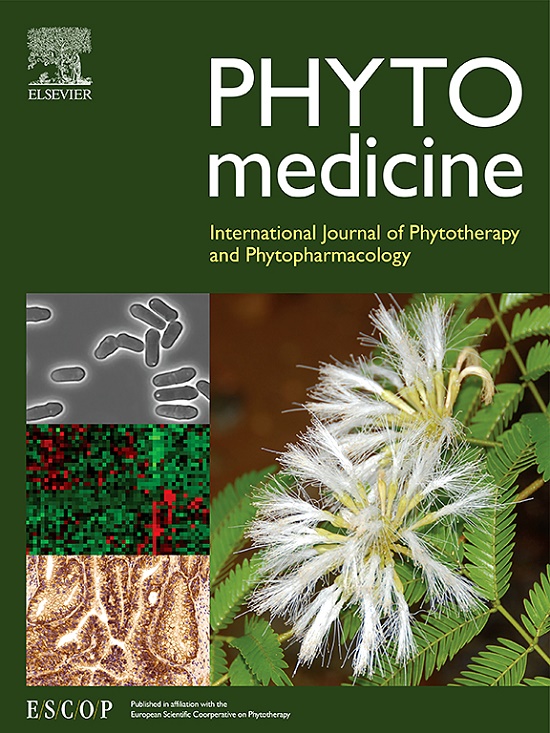天麻素通过抑制 P-glycoprotein 泛素化降低阿尔茨海默氏症小鼠模型的脑内 Aβ 含量。
IF 8.3
1区 医学
Q1 CHEMISTRY, MEDICINAL
引用次数: 0
摘要
背景:研究表明,天麻素具有治疗阿尔茨海默病(AD)的潜力,但其作用机制仍难以捉摸。目前,淀粉样蛋白-β(Aβ)级联假说仍然是有关阿尔茨海默病病因的主流理论。P-糖蛋白(P-gp)在血脑屏障(BBB)上的泛素化导致了Aβ在AD发病过程中在脑内的蓄积:方法:采用分子对接、分子动力学模拟和微尺度热泳(MST)等方法确定天麻素的作用靶点。方法:采用分子对接、分子动力学模拟和微尺度热泳(MST)等方法确定天麻素的作用靶点。采用 NBD-CSA 荧光检测法检测 P-gp 的转运活性。跨上皮细胞电阻(TEER)用于检测细胞电阻。荧光素标记葡聚糖实验用于确定单个细胞的通透性。利用免疫荧光(IF)检测Aβ沉积,利用莫里斯水迷宫试验评估APP/PS1小鼠的行为变化,并利用酶联免疫吸附试验量化Aβ40和Aβ42的表达水平:结果:FBXO15是胃泌素介导的P-gp泛素化抑制作用的靶点。天麻素通过减少FBXO15和P-gp的结合以及抑制P-gp泛素化等机制,提高了Aβ40处理后BEND.3细胞的P-gp表达、细胞抵抗力和P-gp转运活性。天麻素能有效改善APP/PS1小鼠的记忆功能和增加神经元数量,减少Aβ40和Aβ42的积累,并以剂量依赖的方式增强P-gp的表达:结论:Aβ40能诱导BBB P-gp泛素化和蛋白酶体降解,而胃泌素能通过与FBXO15结合抑制P-gp的泛素化,从而增加P-gp蛋白的表达并增强其转运功能。本文章由计算机程序翻译,如有差异,请以英文原文为准。

Gastrodin reduces Aβ brain levels in an Alzheimer's disease mouse model by inhibiting P-glycoprotein ubiquitination
Background
Studies have demonstrated the potential of gastrodin in the treatment of Alzheimer's disease (AD), however, its mechanism of action remains elusive. Currently, the Amyloid-β (Aβ) cascade hypothesis continues to be the prevailing theory regarding AD etiology. The ubiquitination of P-glycoprotein (P-gp) at the blood-brain barrier (BBB) contributes to the accumulation of Aβ in the brain during AD.
Purpose
To investigate the mechanism of gastrodin intervention in AD.
Methods
The molecular docking, molecular dynamics simulations, and microscale thermophoresis (MST) were employed to identify the action target of gastrodin. The western blot (WB) was performed to detect the protein expression level, the ubiquitination level of P-gp was determined using co-immunoprecipitation (CO-IP) assay. P-gp transport activity was detected using an NBD-CSA fluorescence assay. Trans-Epithelial Electrical Resistance (TEER) was used to detect cell resistance. Fluorescein-labeled dextran experiments were performed to determine the individual cell permeability. The immunofluorescence (IF) was employed to detect Aβ deposition, the Morris Water Maze test was used to assess behavioral changes in APP/PS1 mice and the levels of Aβ40 and Aβ42 expression were quantified using enzyme-linked immunosorbent assay.
Results
The FBXO15 was the target of gastrodin-mediated inhibition of P-gp ubiquitination. Gastrodin increased the P-gp expression, cell resistance, and P-gp transport activity of BEND.3 cells upon treatment with Aβ40 through mechanisms involving the reduction of FBXO15 and P-gp binding and the inhibition of P-gp ubiquitination. And gastrodin could effectively improve memory function and increase number of neurons in APP/PS1 mice, reduce the accumulation of Aβ40 and Aβ42, and enhance P-gp expression in a dose-dependent manner.
Conclusion
Aβ40 induces the ubiquitination and proteasomal degradation of BBB P-gp, however, gastrodin inhibits the ubiquitination of P-gp by binding to FBXO15, thereby increasing P-gp protein expression and enhancing its transport function.
求助全文
通过发布文献求助,成功后即可免费获取论文全文。
去求助
来源期刊

Phytomedicine
医学-药学
CiteScore
10.30
自引率
5.10%
发文量
670
审稿时长
91 days
期刊介绍:
Phytomedicine is a therapy-oriented journal that publishes innovative studies on the efficacy, safety, quality, and mechanisms of action of specified plant extracts, phytopharmaceuticals, and their isolated constituents. This includes clinical, pharmacological, pharmacokinetic, and toxicological studies of herbal medicinal products, preparations, and purified compounds with defined and consistent quality, ensuring reproducible pharmacological activity. Founded in 1994, Phytomedicine aims to focus and stimulate research in this field and establish internationally accepted scientific standards for pharmacological studies, proof of clinical efficacy, and safety of phytomedicines.
 求助内容:
求助内容: 应助结果提醒方式:
应助结果提醒方式:


